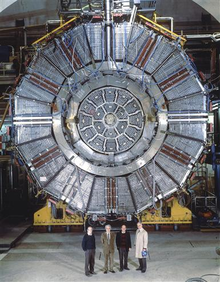
The Compact Muon Solenoid (CMS) experiment is one of two large general-purpose particle physics detectors built on the Large Hadron Collider (LHC) at CERN in Switzerland and France. The goal of the CMS experiment is to investigate a wide range of physics, including the search for the Higgs boson, extra dimensions, and particles that could make up dark matter.

The Large Electron–Positron Collider (LEP) was one of the largest particle accelerators ever constructed. It was built at CERN, a multi-national centre for research in nuclear and particle physics near Geneva, Switzerland.
A wire chamber or multi-wire proportional chamber is a type of proportional counter that detects charged particles and photons and can give positional information on their trajectory, by tracking the trails of gaseous ionization. The technique was an improvement over the bubble chamber particle detection method, which used photographic techniques, as it allowed high speed electronics to track the particle path.

The Compact Linear Collider (CLIC) is a concept for a future linear particle accelerator that aims to explore the next energy frontier. CLIC would collide electrons with positrons and is currently the only mature option for a multi-TeV linear collider. The accelerator would be between 11 and 50 km long, more than ten times longer than the existing Stanford Linear Accelerator (SLAC) in California, US. CLIC is proposed to be built at CERN, across the border between France and Switzerland near Geneva, with first beams starting by the time the Large Hadron Collider (LHC) has finished operations around 2035.

The Underground Area 2 (UA2) experiment was a high-energy physics experiment at the Proton-Antiproton Collider — a modification of the Super Proton Synchrotron (SPS) — at CERN. The experiment ran from 1981 until 1990, and its main objective was to discover the W and Z bosons. UA2, together with the UA1 experiment, succeeded in discovering these particles in 1983, leading to the 1984 Nobel Prize in Physics being awarded to Carlo Rubbia and Simon van der Meer. The UA2 experiment also observed the first evidence for jet production in hadron collisions in 1981, and was involved in the searches of the top quark and of supersymmetric particles. Pierre Darriulat was the spokesperson of UA2 from 1981 to 1986, followed by Luigi Di Lella from 1986 to 1990.
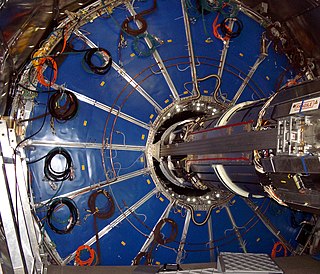
In physics, a time projection chamber (TPC) is a type of particle detector that uses a combination of electric fields and magnetic fields together with a sensitive volume of gas or liquid to perform a three-dimensional reconstruction of a particle trajectory or interaction.
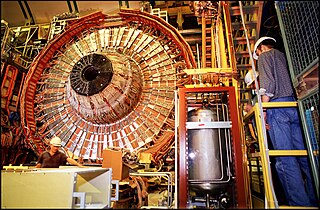
DELPHI was one of the four main detectors of the Large Electron–Positron Collider (LEP) at CERN, one of the largest particle accelerators ever made. Like the other three detectors, it recorded and analyzed the result of the collision between LEP's colliding particle beams. The specific focus of DELPHI was on particle identification, three-dimensional information, high granularity (detail), and precise vertex determination.
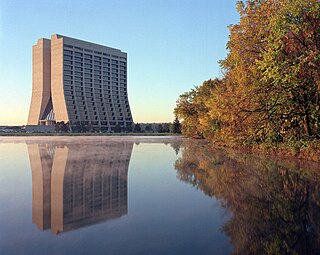
The Collider Detector at Fermilab (CDF) experimental collaboration studies high energy particle collisions from the Tevatron, the world's former highest-energy particle accelerator. The goal is to discover the identity and properties of the particles that make up the universe and to understand the forces and interactions between those particles.

ALICE is one of nine detector experiments at the Large Hadron Collider at CERN. The experiment is designed to study the conditions that are thought to have existed immediately after the Big Bang by measuring properties of quark-gluon plasma.

The DØ experiment was a worldwide collaboration of scientists conducting research on the fundamental nature of matter. DØ was one of two major experiments located at the Tevatron Collider at Fermilab in Batavia, Illinois. The Tevatron was the world's highest-energy accelerator from 1983 until 2009, when its energy was surpassed by the Large Hadron Collider. The DØ experiment stopped taking data in 2011, when the Tevatron shut down, but data analysis is still ongoing. The DØ detector is preserved in Fermilab's DØ Assembly Building as part of a historical exhibit for public tours.
The Mark I, also known as the SLAC-LBL Magnetic Detector, was a particle detector that operated at the interaction point of the SPEAR collider from 1973 to 1977. It was the first 4π detector, i.e. the first detector to uniformly cover as much of the 4π steradians around the interaction point as possible with different types of component particle detectors arranged in layers. This design proved quite successful, and the detector was used in discoveries of the
J/ψ
particle and tau lepton, which both resulted in Nobel prizes. This basic design philosophy continues to be used in all modern collider detectors.
T2K is a particle physics experiment studying the oscillations of the accelerator neutrinos. The experiment is conducted in Japan by the international cooperation of about 500 physicists and engineers with over 60 research institutions from several countries from Europe, Asia and North America and it is a recognized CERN experiment (RE13). T2K collected data within its first phase of operation from 2010 till 2021. The second phase of data taking is expected to start in 2023 and last until commencement of the successor of T2K – the Hyper-Kamiokande experiment in 2027.

The MicroMegas detector is a gaseous particle detector and an advancement of the wire chamber. Invented in 1996 by Georges Charpak and Ioannis Giomataris, Micromegas detectors are mainly used in experimental physics, in particular in particle physics, nuclear physics and astrophysics for the detection of ionizing particles.
OPAL was one of the major experiments at CERN's Large Electron–Positron Collider. OPAL studied particles and their interactions by collecting and analysing electron-positron collisions. There were over three-hundred physicists from 32 institutions involved in the collaboration.

The L3 experiment was one of the four large detectors on the Large Electron–Positron Collider (LEP). The detector was designed to look for the physics of the Standard Model and beyond. It started up in 1989 and stopped taking data in November 2000 to make room for construction of the Large Hadron Collider (LHC). Now, the ALICE detector sits in the cavern that L3 used to occupy, reusing L3's characteristic red octagonal magnet.

The NA62 experiment is a fixed-target particle physics experiment in the North Area of the SPS accelerator at CERN. The experiment was approved in February 2007. Data taking began in 2015, and the experiment is expected to become the first in the world to probe the decays of the charged kaon with probabilities down to 10−12. The experiment's spokesperson is Cristina Lazzeroni. The collaboration involves 333 individuals from 30 institutions and 13 countries around the world.
The Beijing Spectrometer III is a particle physics experiment at the Beijing Electron–Positron Collider II at the Institute of High Energy Physics (IHEP). It is designed to study the physics of charm, charmonium, and light hadron decays. It also performs studies of the tau lepton, tests of QCD, and searches for physics beyond the Standard Model. The experiment started collecting data in the summer of 2008.
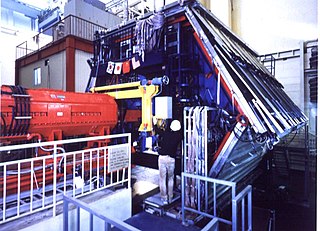
The AMY detector was used by particle physicists at the TRISTAN electron-positron collider at KEK in Japan between 1984 and 1995 to search for new particles and perform precision studies of the strong and electroweak forces.

The Underground Area 7 (UA7) experiment was a high-energy physics experiment at the Proton-Antiproton Collider, a modification of the Super Proton Synchrotron (SPS), at CERN. The purpose of the experiment was to measure the invariant cross section of photons and neutral pions (π0) emitted close to zero degrees, by using silicon shower detectors. The experiment data taking ran from 1985 to 1986, and the final analysis was completed in 1996.
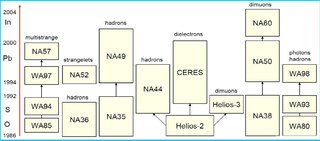
WA93 experiment was a detector experiment conducted at CERN for studying the correlations between photons and charged particles. It was an experimental program of CERN and part of the research programme SPS. The experiment was majorly conducted by the Indian High-Energy Heavy Ion Physics Team at CERN-SPS. For measurement of the multiplicity and the rapidity and azimuthal distributions of photons in ultra-relativistic heavy ion collisions, Photon Multiplicity Detector was implemented in the experiment. The experiment was led by Indian physicist Y P Viyogi. Hans H. Gutbrod was the spokesperson of the experimental project. The experimental project was approved on 22 November 1990. The experiment was completed on 9th May 2002.
